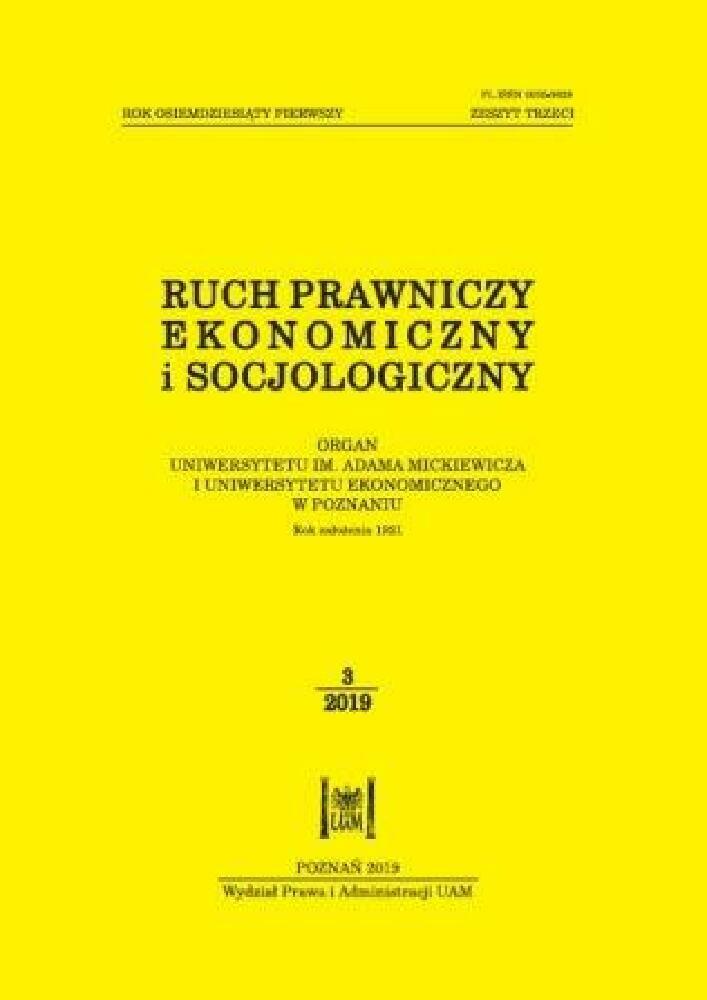Abstract
Bitcoin can be exchanged for other cryptocurrencies as well as for fiat currencies on many different platforms. Nevertheless, its real convertibility may be limited by market liquidity. The main aim of this article is to characterize and compare big and small bitcoin markets in terms of liquidity. I examine four platforms with high trade volume: Kraken, Bitstamp, BitFlyer and BTCBOX, as well as small entities which enable bitcoin to be traded in Polish zloty: BitBay and BitMarket. I compare the number of trades and the time between trades on selected bitcoin markets, determine the volume distribution throughout the day and analyse the dynamics of Amihud’s illiquidity measure – ILLIQ. I find that an exchange which is among the global leaders in terms of trading bitcoin in a particular traditional currency can be considered a smaller market in terms of trade volume in another traditional currency. Moreover, the results imply that BitBay and BitMarket can be perceived as local markets. They are mainly used for trading in Polish zloty, and are illiquid in terms of trading in the remaining traditional currencies. Home bias, the fact that they offer a possibility of trading in a less popular currency (in comparison to the world reserve currencies), and that have their interface in Polish, may give these platforms a competitive advantage.References
Antonopoulos, A.M. (2018). Mastering Bitcoin. O’Reilly Media. https://github.com/bitcoinbook/bitcoinbook [accessed 13 March 2019].
Amihud, Y. (2002). Illiquidity and stock returns: cross-section and time-series effects. Journal of Financial Markets 5: 31–56.
Azzi, G., Bouri, E., Hagfors, L.I., Molnár, P., Roubaud, D. (2017). On the hedge and safe haven properties of bitcoin: is it really more than a diversifier? Finance Research Letters 20: 192–198.
Baur, D.G., Hong, K., Lee, A.D. (2018). Bitcoin: medium of exchange or speculative assets? Journal of International Financial Markets. Institutions and Money 54: 177–189.
Będowska-Sójka, B., Echaust, K. (2018). Commonality in liquidity and the dynamics of the liquidity indices: the evidence from the emerging European stock markets. https://www.researchgate.net/publication/325735275 [accessed 22 March 2019].
Bhaskar, N.D., Lee, D.K.C. (2015). Bitcoin exchanges, [in:] D.K.C. Lee (ed.), Handbook of Digital Currency. Bitcoin, Innovation, Financial Instruments and Big Data. San Diego: Elsevier: 559–573.
Bitcoincharts (2019). Exchange volume distribution. https://bitcoincharts.com/charts/volumepie [accessed 27 March 2019].
Black, F. (1971). Toward a fully automated stock exchange. Part I. Financial Analysts Journal 27(4): 25–35.
Brandvold, M., Molnár, P., Vagstad, K., Valstad, O. (2015). Price discovery on bitcoin exchanges. Journal of International Financial Markets. Institutions and Money 36: 18–35.
Brauneis, A., Mestel, R. (2018). Price discovery of cryptocurrencies: bitcoin and beyond. Economics Letters 165: 58–61.
Briere, M., Oosterlinck, K., Szafarz, A. (2015). Virtual currency, tangible return: portfolio diversification with bitcoin. Journal of Asset Management 16(6): 365–373.
Carrick, J. (2016). Bitcoin as a complement to emerging market currencies. Emerging Markets Finance and Trade 52(10): 2321–2334.
CoinMarketCap (2019). 24 Hour Volume Rankings (All Exchanges). https://coinmarketcap.com/exchanges/volume/24-hour/all/ [accessed 27 March 2019].
Dimpfl, T. (2017). Bitcoin market microstructure. https://papers.ssrn.com/sol3/papers.cfm?abstract_id=2949807 [accessed 7 March 2018].
Doman, M. (2011). Mikrostruktura giełd papierów wartościowych. Poznań: Wydawnictwo Uniwersytetu Ekonomicznego w Poznaniu.
European Central Bank (2015). Virtual currency schemes – a further analysis. https://www.ecb.europa.eu/pub/pdf/other/virtualcurrencyschemesen.pdf [accessed 28 November 2018].
Glaser, F., Haferkorn, M., Siering, M., Weber, M.C., Zimmermann, K. (2014). Bitcoin – asset or currency? Revealing users’ hidden intentions. Proceedings of the European Conference on Information Systems (ECIS). Tel Aviv.
Harris, L. (2003). Trading and Exchanges: Market Microstructure for Practitioners. Oxford: Oxford University Press.
Hileman, G., Rauchs, M. (2017). Global Cryptocurrency Benchmarking Study. Cambridge: Centre for Alternative Finance.
Jonker, N. (2018). What drives bitcoin adoption by retailers? Working Paper no. 585. Amsterdam: De Nederlandsche Bank.
Lesmond, D.A. (2005). Liquidity of emerging markets. Journal of Financial Economics 77(2): 411–452.
Loi, H. (2018). The liquidity of bitcoin. International Journal of Economics and Finance 10(1): 13–22.
Moore, T., Christin, N. (2013). Beware the middleman: empirical analysis of bitcoin-exchange risk, [in:] A. Sadeghi (ed.), Financial Cryptography and Data Security. Berlin: Springer: 25–33.
Nakamoto, S. (2008). Bitcoin: a peer-to-peer electronic cash system. bitcoin.org/bitcoin.pdf [accessed 21 December 2017].
Pandey, V.K., Wu, C.Y. (2014). The value of bitcoin in enhancing the efficiency of an investor’s portfolio. Journal of Financial Planning 27(9): 44–52.
Piotrowska, A.I. (2018). Bitcoin. Płatnicze i inwestycyjne zastosowania kryptowaluty. Warszawa: CeDeWu.
Polasik, M., Piotrowska, A.I., Wiśniewski, T.P., Kotkowski, R., Lightfoot, G. (2015). Price fluctuations and the use of bitcoin: an empirical inquiry. International Journal of Electronic Commerce 20(1): 9–49.
Poskart, R. (2017). Giełdy bitcoina w Polsce. Przegląd Nauk Stosowanych 16: 113–125.
Shi, S. (2017). The impact of futures trading on intraday spot volatility and liquidity: evidence from bitcoin market. https://ssrn.com/abstract=3094647 [accessed 3 April 2018].
Teo, E.G.S. (2015). Emergence, growth, and sustainability of bitcoin: the network economics perspective, [in:] D.K.C. Lee (ed.), Handbook of Digital Currency. Bitcoin, Innovation, Financial Instruments, and Big Data. San Diego: Elsevier: 191–200.
Thies, S., Molnár, P. (2018). Bayesian change point analysis of bitcoin returns. Finance Research Letters 27: 223–227.
Trimborn, S., Li, M., Härdle, W.K. (2017). Investing with cryptocurrencies – a liquidity constrained investment approach. SFB 649 Discussion Paper 2017-014.
Yermack, D. (2015). Is bitcoin a real currency? An economic appraisal, [in:] D.K.C. Lee (ed.), Handbook of Digital Currency. Bitcoin, Innovation, Financial Instruments and Big Data. San Diego: Elsevier: 31–43.
License
Copyright (c) 2019 WPiA UAM

This work is licensed under a Creative Commons Attribution-NonCommercial-NoDerivatives 4.0 International License.





